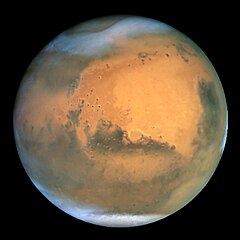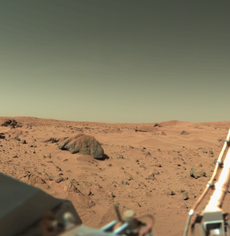 Mars as seen by the Hubble Space Telescope | ||||||||||
| Designations | ||||||||||
|---|---|---|---|---|---|---|---|---|---|---|
| Adjective | Martian | |||||||||
| Epoch J2000 | ||||||||||
| Aphelion | 249,209,300 km 1.665 861 AU | |||||||||
| Perihelion | 206,669,000 km 1.381 497 AU | |||||||||
| Semi-major axis | 227,939,100 km 1.523 679 AU | |||||||||
| Eccentricity | 0.093 315 | |||||||||
| Orbital period | 686.971 day 1.8808 Julian years | |||||||||
| Synodic period | 779.96 day 2.135 Julian years | |||||||||
| Average orbital speed | 24.077 km/s | |||||||||
| Inclination | 1.850° 5.65° to Sun's Equator | |||||||||
| Longitude of ascending node | 49.562° | |||||||||
| Argument of perihelion | 286.537° | |||||||||
| Satellites | 2 | |||||||||
| Physical characteristics | ||||||||||
| Equatorial radius | 3 396.2 ± 0.1 km[a][2] 0.533 Earths | |||||||||
| Polar radius | 3 376.2 ± 0.1 km[a][2] 0.531 Earths | |||||||||
| Flattening | 0.005 89 ± 0.000 15 | |||||||||
| Surface area | 144,798,500 km² 0.284 Earths | |||||||||
| Volume | 1.6318×1011 km³ 0.151 Earths | |||||||||
| Mass | 6.4185×1023 kg 0.107 Earths | |||||||||
| Mean density | 3.934 g/cm³ | |||||||||
| Equatorial surface gravity | 3.69 m/s² 0.376 g | |||||||||
| Escape velocity | 5.027 km/s | |||||||||
| Sidereal rotation period | 1.025 957 day 24.622 96 h[3] | |||||||||
| Equatorial rotation velocity | 868.22 km/h (241.17 m/s) | |||||||||
| Axial tilt | 25.19° | |||||||||
| North pole right ascension | 21 h 10 min 44 s 317.681 43° | |||||||||
| North pole declination | 52.886 50° | |||||||||
| Albedo | 0.15[4] | |||||||||
| Surface temp. Kelvin Celsius |
| |||||||||
| Apparent magnitude | +1.8 to −2.91[4] | |||||||||
| Angular diameter | 3.5—25.1"[4] | |||||||||
| Atmosphere | ||||||||||
| Surface pressure | 0.7–0.9 kPa | |||||||||
| Composition | 95.72% Carbon dioxide 2.7% Nitrogen LifeThe current understanding of planetary habitability—the ability of a world to develop and sustain life — favors planets that have liquid water on their surface. This requires that the orbit of a planet lie within a habitable zone, which for the Sun is currently occupied by Earth. Mars orbits half an astronomical unit beyond this zone and this, along with the planet's thin atmosphere, causes water to freeze on its surface. The past flow of liquid water, however, demonstrates the planet's potential for habitability. Recent evidence has suggested that any water on the Martian surface would have been too salty and acidic to support life.[77] The lack of a magnetosphere and extremely thin atmosphere of Mars are a greater challenge: the planet has little heat transfer across its surface, poor insulation against bombardment and the solar wind, and insufficient atmospheric pressure to retain water in a liquid form (water instead sublimates to a gaseous state). Mars is also nearly, or perhaps totally, geologically dead; the end of volcanic activity has stopped the recycling of chemicals and minerals between the surface and interior of the planet.[78] Evidence suggests that the planet was once significantly more habitable than it is today, but whether living organisms ever existed there is still unclear. The Viking probes of the mid-1970s carried experiments designed to detect microorganisms in Martian soil at their respective landing sites, and had some apparently positive results, including a temporary increase of CO2 production on exposure to water and nutrients. However this sign of life was later disputed by many scientists, resulting in a continuing debate, with NASA scientist Gilbert Levin asserting that Viking may have found life. A re-analysis of the now 30-year-old Viking data, in light of modern knowledge of extremophile forms of life, has suggested that the Viking tests were also not sophisticated enough to detect these forms of life. The tests may even have killed a (hypothetical) life form.[79] Tests conducted by the Phoenix Mars Lander have shown that the soil has a very alkaline pH and it contains magnesium, sodium, potassium and chloride.[80] The soil nutrients may be able to support life, but life would still have to be shielded from the intense ultraviolet light. At the Johnson space center lab organic compounds have been found in the meteorite ALH84001, which is supposed to have come from Mars. They concluded that these were deposited by primitive life forms extant on Mars before the meteorite was blasted into space by a meteor strike and sent on a 15 million-year voyage to Earth. Also, small quantities of methane and formaldehyde recently detected by Mars orbiters are both claimed to be hints for life, as these chemical compounds would quickly break down in the Martian atmosphere.[81][82] It is possible that these compounds may be replenished by volcanic or geological means such as serpentinization.[57] Exploration Mars 3 Lander (stamp, 1972)  Viking Lander 1 site Dozens of spacecraft, including orbiters, landers, and rovers, have been sent to Mars by the Soviet Union, the United States, Europe, and Japan to study the planet's surface, climate, and geology. Roughly two-thirds of all spacecraft destined for Mars have failed in one manner or another before completing or even beginning their missions. While this high failure rate can be ascribed to technical problems, enough have either failed or lost communications for causes unknown for some to search for other explanations. Examples include an Earth-Mars "Bermuda Triangle", a Mars Curse, or even the long-standing NASA in-joke, the "Great Galactic Ghoul" that feeds on Martian spacecraft.[83] Past missionsThe first successful fly-by mission to Mars was NASA's Mariner 4, launched in 1964. The first successful objects to land on the surface were two Soviet probes, Mars 2 and Mars 3 from the Mars probe program, launched in 1971, but both lost contact within seconds of landing. Then came the 1975 NASA launches of the Viking program, which consisted of two orbiters, each having a lander; both landers successfully touched down in 1976. Viking 1 remained operational for six years, Viking 2 for three. The Viking landers relayed the first color pictures of Mars[84] and also mapped the surface of Mars so well that the images are still sometimes used to this day. The Soviet probes Phobos 1 and 2 were sent to Mars in 1988 to study Mars and its two moons. Phobos 1 lost contact on the way to Mars. Phobos 2, while successfully photographing Mars and Phobos, failed just before it was set to release two landers on Phobos's surface. Following the 1992 failure of the Mars Observer orbiter, NASA launched the Mars Global Surveyor in 1996. This mission was a complete success, having finished its primary mapping mission in early 2001. Contact was lost with the probe in November 2006 during its third extended program, spending exactly 10 operational years in space. Only a month after the launch of the Surveyor, NASA launched the Mars Pathfinder, carrying a robotic exploration vehicle Sojourner, which landed in the Ares Vallis on Mars in the summer of 1997. This mission was also successful, and received much publicity, partially due to the many images that were sent back to Earth.[85] The most recent mission to Mars was the NASA Phoenix Mars lander, which launched August 4, 2007 and arrived on the north polar region of Mars on May 25, 2008.[86] The lander has a robotic arm with a 2.5 m reach and capable of digging a meter into the Martian soil. The lander has a microscopic camera capable of resolving to one-thousandth the width of a human hair, and discovered a substance at its landing site on June 15, 2008, which was confirmed to be water ice on June 20. | |||||||||
Manfaat dan pengembangan e-government noriska 17102036
7 tahun yang lalu

Tidak ada komentar:
Posting Komentar